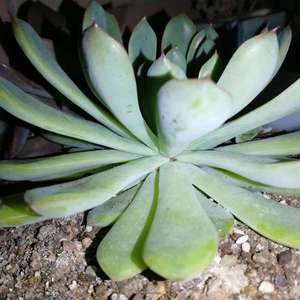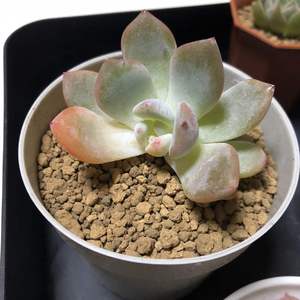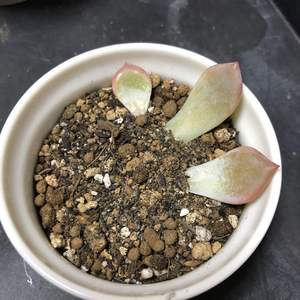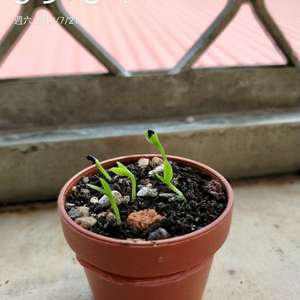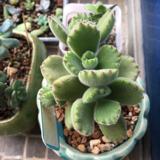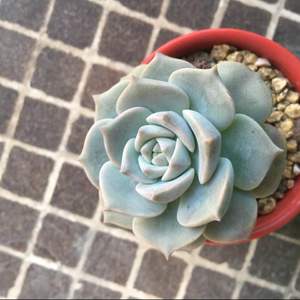文章
Miss Chen
2018年07月25日

Description: This plant is a summer annual that becomes 2-8' tall, branching occasionally. The stems are usually glabrous and glaucous; sometimes they have scattered stiff hairs toward the base. The alternate leaves are up to 10" long and 3" across, becoming smaller as they ascend the stems. The lower leaves are pinnately lobed and obovate in outline, tapering to a long and rather stout petiole. The terminal lobe is much larger than the lateral lobes. The upper surface of a lower leaf is often bristly with scattered hairs that are stiff, short, and white. The lower surface is usually glabrous, except for a few hairs along the central vein. The upper leaves are often lanceolate, broadly elliptic, or some other odd shape; they have 1-2 lobes or none.
The upper stems terminate in narrow racemes of yellow flowers; these racemes are ½–2' long when fully mature. Each flower is up to 1/3" (8 mm.) across, consisting of 4 yellow petals, 4 sepals, several stamens, and a pistil. The sepals are initially green, but become yellow while the flower blooms. The petals are well-rounded toward their tips. The blooming period occurs primarily during the summer and lasts about 1-2 months. A few plants may bloom during the fall. Each flower is replaced by a slender silique that becomes appressed against the stalk of the raceme as it matures. This silique is about 2/3" (17 mm.) long, tapering to a conical beak. The petiole of the silique (or flower) is about 1/3" (8 mm.) long. The seeds within this silique are dark brown or black. Both the seeds and the foliage have a pungent taste. The root system consists of a taproot. This plant spreads by reseeding itself.

Cultivation: This plant often occurs in full or partial sun, fertile soil, and mesic conditions. On less fertile ground, it is smaller in size. During hot sunny weather the leaves have a tendency to wilt, but they quickly recover by nightfall. Sometimes this plant becomes lanky and flops sideways.
Range & Habitat: The non-native Black Mustard is a common plant in central and northern Illinois, but it is less common or absent in southern Illinois (see Distribution Map). Habitats include weedy meadows, thickets, areas along railroads and roadsides, fallow fields, vacant lots, and miscellaneous waste places. Disturbed areas are preferred; Black Mustard doesn't invade high quality natural areas to any significant degree. It is native to Eurasia.

Faunal Associations: The nectar and pollen of the flowers attract primarily small bees and flower flies; less common visitors include White butterflies and wasps. The foliage is occasionally eaten by the caterpillars of various White butterflies, including Pieris rapae (Cabbage White) and Pontia protodice (Checkered White). The pungent foliage is usually avoided by mammalian herbivores; it is somewhat toxic to them.
Photographic Location: Along a railroad in a partially shaded area in Urbana, Illinois.

Comments: If you see a lanky mustard plant with narrow stalks of yellow flowers that is over your head, there's a good chance that it's Black Mustard. The seeds of Black Mustard are often used in the table condiment, hot mustard. Among the many Brassica spp. and Synapis spp. (Mustards), Black Mustard can be identified by considering the following characteristics: 1) It is often quite tall, 2) the slender siliques are appressed together near the stalk of each raceme, 3) the siliques are less than ¾" long and they have distinct beaks, 4) the leaves narrowly clasp the stems, 5) the terminal lobes of the lower leaves are much larger than the lateral lobes, and 6) the lower leaves often have short stiff hairs and feel bristly to the touch. Other mustards are often lacking one or more of these features.
The upper stems terminate in narrow racemes of yellow flowers; these racemes are ½–2' long when fully mature. Each flower is up to 1/3" (8 mm.) across, consisting of 4 yellow petals, 4 sepals, several stamens, and a pistil. The sepals are initially green, but become yellow while the flower blooms. The petals are well-rounded toward their tips. The blooming period occurs primarily during the summer and lasts about 1-2 months. A few plants may bloom during the fall. Each flower is replaced by a slender silique that becomes appressed against the stalk of the raceme as it matures. This silique is about 2/3" (17 mm.) long, tapering to a conical beak. The petiole of the silique (or flower) is about 1/3" (8 mm.) long. The seeds within this silique are dark brown or black. Both the seeds and the foliage have a pungent taste. The root system consists of a taproot. This plant spreads by reseeding itself.

Cultivation: This plant often occurs in full or partial sun, fertile soil, and mesic conditions. On less fertile ground, it is smaller in size. During hot sunny weather the leaves have a tendency to wilt, but they quickly recover by nightfall. Sometimes this plant becomes lanky and flops sideways.
Range & Habitat: The non-native Black Mustard is a common plant in central and northern Illinois, but it is less common or absent in southern Illinois (see Distribution Map). Habitats include weedy meadows, thickets, areas along railroads and roadsides, fallow fields, vacant lots, and miscellaneous waste places. Disturbed areas are preferred; Black Mustard doesn't invade high quality natural areas to any significant degree. It is native to Eurasia.

Faunal Associations: The nectar and pollen of the flowers attract primarily small bees and flower flies; less common visitors include White butterflies and wasps. The foliage is occasionally eaten by the caterpillars of various White butterflies, including Pieris rapae (Cabbage White) and Pontia protodice (Checkered White). The pungent foliage is usually avoided by mammalian herbivores; it is somewhat toxic to them.
Photographic Location: Along a railroad in a partially shaded area in Urbana, Illinois.

Comments: If you see a lanky mustard plant with narrow stalks of yellow flowers that is over your head, there's a good chance that it's Black Mustard. The seeds of Black Mustard are often used in the table condiment, hot mustard. Among the many Brassica spp. and Synapis spp. (Mustards), Black Mustard can be identified by considering the following characteristics: 1) It is often quite tall, 2) the slender siliques are appressed together near the stalk of each raceme, 3) the siliques are less than ¾" long and they have distinct beaks, 4) the leaves narrowly clasp the stems, 5) the terminal lobes of the lower leaves are much larger than the lateral lobes, and 6) the lower leaves often have short stiff hairs and feel bristly to the touch. Other mustards are often lacking one or more of these features.
0
0
文章
Miss Chen
2018年07月25日

Description: This annual wildflower is 1½–2½' tall, branching occasionally. The stems are light to medium green, terete, hollow, and densely covered with stiff white hairs. Alternate leaves along these stems are 2-6" long and about one-third as much across; they are ovate, obovate, or oblanceolate in shape with margins that are smooth and slightly undulate. The upper leaf surface is dark green, wrinkled from indented veins, and covered with sparse appressed hairs. The lower leaf surface is light to medium green and hairy primarily along the undersides of the veins.
Upper stems terminate in scorpioid cymes of nodding flowers. Individual flowers are ¾-1" across, consisting of 5 lanceolate blue petals (rarely white or pink), 5 green sepals, 5 dark blue to black anthers that merge together to form a central beak, and an ovary with a single style. The linear sepals are covered with stiff white hairs along their outer surfaces; they are about the same length or a little shorter than the petals. Like the stems and sepals, the branches of each inflorescence are covered with stiff white hairs; they are green to dark red. In Illinois, the blooming period occurs from mid-summer into the fall, lasting about 1½-3 months. Each flower is replaced by 4 dark brown nutlets. The root system consists of a taproot. This wildflower spreads by reseeding itself.
Cultivation: The preference is a sunny position, mesic conditions, and a fertile loamy soil.
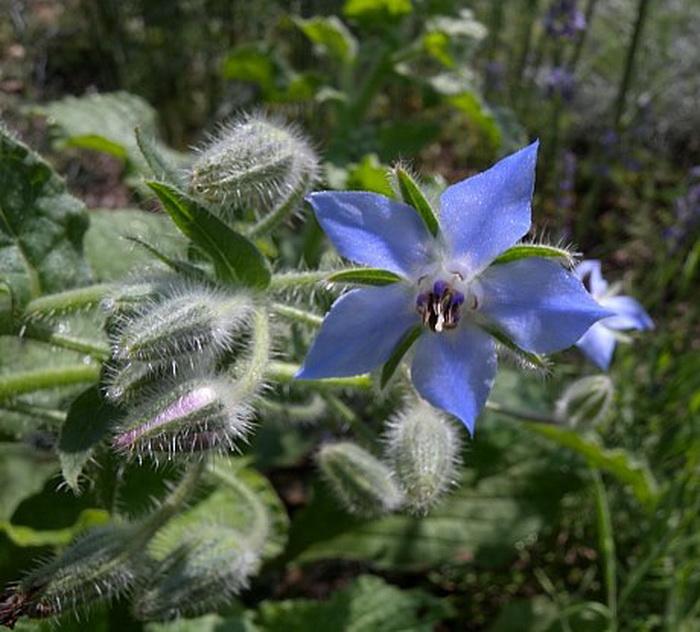
Range & Habitat: Borage has naturalized in only a few counties in Illinois (see Distribution Map). Naturalized populations rarely persist for more than a few years. Borage was introduced into North America from Europe as an herbal and ornamental plant; it is native to the Mediterranean area. Habitats consist of areas near buildings, rubbish heaps consisting of organic material, and waste areas. Borage is still cultivated in gardens.
Faunal Associations: According to Muëller (1873/1883), the nectar and pollen of the flowers attract bees, including honeybees, bumblebees, other long-tongued bees, and Halictid bees. It is unclear to what extent mammalian herbivores in North America feed on the foliage of Borage, which is mildly toxic from the presence of pyrrolizidine alkaloids. Similarly, there is lack of information about the consumption of seeds by birds and rodents.

Photographic Location: An herbal garden at Meadowbrook Park in Urbana, Illinois.
Comments: The most striking aspect of this plant are the star-shaped flowers; the petals have a shade of genuine blue that is uncommon among flowering plants. The flowers are reportedly edible with a sweet taste. The leaves are also eaten in salads and other dishes; they have a cucumber-like flavor. However, because of their potential toxicity, the leaves should be eaten in only small amounts. Because of its unique blue flowers, Borage is easy to identify. Other species in the Borage family have flowers with more conventional corollas.
Upper stems terminate in scorpioid cymes of nodding flowers. Individual flowers are ¾-1" across, consisting of 5 lanceolate blue petals (rarely white or pink), 5 green sepals, 5 dark blue to black anthers that merge together to form a central beak, and an ovary with a single style. The linear sepals are covered with stiff white hairs along their outer surfaces; they are about the same length or a little shorter than the petals. Like the stems and sepals, the branches of each inflorescence are covered with stiff white hairs; they are green to dark red. In Illinois, the blooming period occurs from mid-summer into the fall, lasting about 1½-3 months. Each flower is replaced by 4 dark brown nutlets. The root system consists of a taproot. This wildflower spreads by reseeding itself.
Cultivation: The preference is a sunny position, mesic conditions, and a fertile loamy soil.

Range & Habitat: Borage has naturalized in only a few counties in Illinois (see Distribution Map). Naturalized populations rarely persist for more than a few years. Borage was introduced into North America from Europe as an herbal and ornamental plant; it is native to the Mediterranean area. Habitats consist of areas near buildings, rubbish heaps consisting of organic material, and waste areas. Borage is still cultivated in gardens.
Faunal Associations: According to Muëller (1873/1883), the nectar and pollen of the flowers attract bees, including honeybees, bumblebees, other long-tongued bees, and Halictid bees. It is unclear to what extent mammalian herbivores in North America feed on the foliage of Borage, which is mildly toxic from the presence of pyrrolizidine alkaloids. Similarly, there is lack of information about the consumption of seeds by birds and rodents.

Photographic Location: An herbal garden at Meadowbrook Park in Urbana, Illinois.
Comments: The most striking aspect of this plant are the star-shaped flowers; the petals have a shade of genuine blue that is uncommon among flowering plants. The flowers are reportedly edible with a sweet taste. The leaves are also eaten in salads and other dishes; they have a cucumber-like flavor. However, because of their potential toxicity, the leaves should be eaten in only small amounts. Because of its unique blue flowers, Borage is easy to identify. Other species in the Borage family have flowers with more conventional corollas.
0
0
文章
Miss Chen
2018年07月25日

Description: This plant is a summer annual about 2-5' tall; it is more or less erect and branches occasionally. The stems are green or reddish green, angular, strongly veined, and hairless (or nearly so). The leaves are mostly opposite; their blades are up to 8" long and 4" across, while their petioles are up to 2" long. The leaf blades are double- or triple-pinnate, medium green, and hairless (or nearly so). The segments of the blades are ovate, lanceolate, or oblanceolate with blunt tips and wedge-shaped bottoms; the margins of these segments are irregularly cleft or dentate. Overall, the leaf blades have a fern-like appearance. The upper stems terminate in individual flowerheads on long peduncles. Each flowerhead is about ½" long and ¼" across; it has numerous disk florets in the center and 0-5 ray florets along its upper margin. The disk florets have corollas that are golden yellow and tubular in shape; each corolla has 5 tiny lobes along its upper rim. The yellow ray florets are petal-like; they are about 1/8" (3 mm.) long and oval to oblong in shape. Some flowerheads may lack petal-like extensions of the ray florets altogether. The base of the flowerhead is surrounded by green bracts; the linear inner bracts are much longer (about 1/3" or 8 mm. in length) than the outer bracts. The blooming period occurs during the late summer or early fall. Each flowerhead is replaced by a seedhead that is globoid in shape and spans about 1" across. The long narrow seeds (achenes) spread outward from the center in all directions. Each mature seed is linear in shape, 4-angled, and dark brown; it has 2-4 short awns at its tip. Each tiny awn has downward-pointed barbs. The root system consists of a branching taproot. This plant spreads by reseeding itself.
Cultivation: Partial or dappled sunlight, moist to mesic conditions, and a fertile loamy soil are preferred. However, this robust plant can adapt to a wide range of environmental conditions. The size of individual plants varies significantly, depending on moisture levels and soil fertility.
Range & Habitat: The native Spanish Needles is occasional to locally common in southern and central Illinois; it is mostly absent in the northern section of the state (see Distribution Map). Habitats include open woodlands, woodland borders, savannas, thickets, rocky glades, riverbanks, weedy meadows, vacant lots, partially shaded areas along buildings, areas along railroads and roadsides, abandoned fields, and waste areas. Habitats with a history of disturbance are preferred. In Illinois, Spanish Needles is more often found in drier habitats than other species in the genus.

Faunal Associations: The nectar and pollen of the flowerheads attract bees: these include honeybees, leaf-cutting bees (Megachile spp., Coelioxys sayi, & Heriades leavitti), and Halictid bees (including green metallic bees). Other insect visitors of the flowers include Syrphid flies and the butterfly Pieris rapae (Cabbage White). Rather then visiting the flowers, other insects feed on the foliage and other parts of Bidens spp. These species include the caterpillars of the moths Cirrhophanus triangulifer (Goldenrod Stowaway), Condica confederata (The Confederate), Epiblema otiosana (Bidens Borer Moth), Palthis asopialis (Fainted-Spotted Palthis), Platysenta mobilis (Mobile Groundling), and Synchlora aerata (Wavy-Lined Emerald). The leaf beetles Calligrapha bidenticola and Calligrapha californica feed on the leaves of Bidens spp., while the aphid Aphis coreopsidis sucks juices from the flowering stalks. Many of these insects feed on similar plants in the Aster family. Seeds of Bidens spp. are eaten to a minor extent by various birds, including the Ring-Necked Pheasant, Bobwhite, Wood Duck, Purple Finch, and Common Redpoll. The foliage is sometimes eaten by the Cottontail Rabbit. The barbed awns of the seeds can cling to the fur of passing animals and the clothing of humans; in this manner, the seeds are distributed far and wide.

Photographic Location: The photographs were taken at a small grove of trees along a railroad in Champaign, Illinois, and a vacant lot in Urbana, Illinois. In one photograph, a green metallic bee is visiting a flowerhead. Underneath this flowerhead, there are some greenish aphids sucking juices from the stalk, although they are difficult to see.
Comments: The arrangement of the trident-shaped seeds into globoid seedheads is very striking. The common name derives from the appearance of these seeds. Among the many Bidens spp. in Illinois, Spanish Needles is the oddball of the group. The seeds of Spanish Needles are longer and usually more slender than those of other Bidens spp. Spanish Needles also has differently shaped leaves – they are more pinnately divided into smaller leaf segments than the leaves of other Bidens spp. (which are sometimes simple, rather than compound). Finally, Spanish Needles seems to prefer drier habitats; other Bidens spp. are more likely to be found in various wetland habitats.
Cultivation: Partial or dappled sunlight, moist to mesic conditions, and a fertile loamy soil are preferred. However, this robust plant can adapt to a wide range of environmental conditions. The size of individual plants varies significantly, depending on moisture levels and soil fertility.
Range & Habitat: The native Spanish Needles is occasional to locally common in southern and central Illinois; it is mostly absent in the northern section of the state (see Distribution Map). Habitats include open woodlands, woodland borders, savannas, thickets, rocky glades, riverbanks, weedy meadows, vacant lots, partially shaded areas along buildings, areas along railroads and roadsides, abandoned fields, and waste areas. Habitats with a history of disturbance are preferred. In Illinois, Spanish Needles is more often found in drier habitats than other species in the genus.

Faunal Associations: The nectar and pollen of the flowerheads attract bees: these include honeybees, leaf-cutting bees (Megachile spp., Coelioxys sayi, & Heriades leavitti), and Halictid bees (including green metallic bees). Other insect visitors of the flowers include Syrphid flies and the butterfly Pieris rapae (Cabbage White). Rather then visiting the flowers, other insects feed on the foliage and other parts of Bidens spp. These species include the caterpillars of the moths Cirrhophanus triangulifer (Goldenrod Stowaway), Condica confederata (The Confederate), Epiblema otiosana (Bidens Borer Moth), Palthis asopialis (Fainted-Spotted Palthis), Platysenta mobilis (Mobile Groundling), and Synchlora aerata (Wavy-Lined Emerald). The leaf beetles Calligrapha bidenticola and Calligrapha californica feed on the leaves of Bidens spp., while the aphid Aphis coreopsidis sucks juices from the flowering stalks. Many of these insects feed on similar plants in the Aster family. Seeds of Bidens spp. are eaten to a minor extent by various birds, including the Ring-Necked Pheasant, Bobwhite, Wood Duck, Purple Finch, and Common Redpoll. The foliage is sometimes eaten by the Cottontail Rabbit. The barbed awns of the seeds can cling to the fur of passing animals and the clothing of humans; in this manner, the seeds are distributed far and wide.

Photographic Location: The photographs were taken at a small grove of trees along a railroad in Champaign, Illinois, and a vacant lot in Urbana, Illinois. In one photograph, a green metallic bee is visiting a flowerhead. Underneath this flowerhead, there are some greenish aphids sucking juices from the stalk, although they are difficult to see.
Comments: The arrangement of the trident-shaped seeds into globoid seedheads is very striking. The common name derives from the appearance of these seeds. Among the many Bidens spp. in Illinois, Spanish Needles is the oddball of the group. The seeds of Spanish Needles are longer and usually more slender than those of other Bidens spp. Spanish Needles also has differently shaped leaves – they are more pinnately divided into smaller leaf segments than the leaves of other Bidens spp. (which are sometimes simple, rather than compound). Finally, Spanish Needles seems to prefer drier habitats; other Bidens spp. are more likely to be found in various wetland habitats.
0
0
文章
Miss Chen
2018年07月25日

Description: This perennial plant has sword-shaped alternate leaves about ¾–2' long; they originate primarily toward the bottom of the flowering stalk. These leaves are often grouped together into the shape of a fan; they are green to grey-blue, linear in shape, glabrous, and glaucous. Their margins are smooth, while their veins are parallel. The erect central stalk is 2–3½' tall and either branched or unbranched; it is terete, fairly stout, glabrous, glaucous, and pale green. This stalk terminates in a cyme or compound cyme of flowers. There are pairs of small linear-lanceolate bracts at each fork of the stalk; these bracts are slightly membranous and tend to wither away. Each flower spans about 1¼–2" across, consisting of 6 spreading tepals, 3 distinct stamens, a style with a tripartite stigma, and an inferior ovary. The tepals are orange with purple dots and elliptic-oblong in shape, while the ovary is green, glabrous, and narrowly ovoid. Each cyme usually produces several flowers. The blooming period occurs from mid- to late summer and lasts about 1-2 months. There is no noticeable floral scent. Each flower is replaced by an oblongoid seed capsule about 1" long; the 3 sides of this capsule become strongly recurved, revealing a mass of shiny black seeds that resembles a blackberry. The root system consists of a thickened crown at the base of the plant, which has fibrous roots underneath; spreading rhizomes are also produced. Both the crown and rhizomes have an orange interior. This plant can spread by either rhizomes or seeds.
Cultivation: The preference is full or partial sun, moist to dry conditions, and soil that is loamy, rocky, or sandy. The flowers and foliage are rarely bothered by disease or insect pests.
Range & Habitat: Blackberry Lily has naturalized throughout Illinois in widely scattered locations (see Distribution Map). In the wild, it is uncommon, although its population within the state may be increasing. Habitats include thin woodlands, rocky bluffs, hillsides, fallow fields, roadsides, and sites of old homesteads. Blackberry Lily was introduced from East Asia as an ornamental plant and it is often cultivated in gardens because of the attractive foliage and flowers.
Faunal Associations: Very little is known about floral-faunal relationships for this introduced plant. The flowers offer nectar and pollen to insects and other floral visitors, but it unclear who these visitors are. There are anecdotal reports that the seeds are eaten by birds.

Photographic Location: A flower garden at the Arboretum of the University of Illinois in Urbana, Illinois.
Comments: This remarkable plant has the leaves of an iris (Iris sp.), the flowers of a lily (Lilium sp.), and a fruit that resembles a blackberry (Rubus sp.). There is nothing that quite resembles it. The flower of Blackberry Lily has only 3 stamens, while the flower of a lily has 6 stamens. The Blackberry Lily differs from other members of the Iris family in having 3 distinct stamens that are not petal-like in appearance. It is still unclear whether the Blackberry Lily will become invasive. Another common name of this species is the Leopard Lily.
Cultivation: The preference is full or partial sun, moist to dry conditions, and soil that is loamy, rocky, or sandy. The flowers and foliage are rarely bothered by disease or insect pests.
Range & Habitat: Blackberry Lily has naturalized throughout Illinois in widely scattered locations (see Distribution Map). In the wild, it is uncommon, although its population within the state may be increasing. Habitats include thin woodlands, rocky bluffs, hillsides, fallow fields, roadsides, and sites of old homesteads. Blackberry Lily was introduced from East Asia as an ornamental plant and it is often cultivated in gardens because of the attractive foliage and flowers.
Faunal Associations: Very little is known about floral-faunal relationships for this introduced plant. The flowers offer nectar and pollen to insects and other floral visitors, but it unclear who these visitors are. There are anecdotal reports that the seeds are eaten by birds.

Photographic Location: A flower garden at the Arboretum of the University of Illinois in Urbana, Illinois.
Comments: This remarkable plant has the leaves of an iris (Iris sp.), the flowers of a lily (Lilium sp.), and a fruit that resembles a blackberry (Rubus sp.). There is nothing that quite resembles it. The flower of Blackberry Lily has only 3 stamens, while the flower of a lily has 6 stamens. The Blackberry Lily differs from other members of the Iris family in having 3 distinct stamens that are not petal-like in appearance. It is still unclear whether the Blackberry Lily will become invasive. Another common name of this species is the Leopard Lily.
0
0
文章
Miss Chen
2018年07月25日

Description: This herbaceous biennial plant is 1–2½' tall. During the first year it forms a rosette of basal leaves up to 1' across, while during the second year it bolts upward with one or more flowering stalks. These stalks are hairless, stout, light green to reddish purple, and somewhat angular. Secondary stalks are produced in the upper half of the plant. The basal leaves are up to 6" long and 2½" across. They are odd-pinnate with 1-4 pairs of lateral lobes and a terminal lobe that is larger than the others. These lobes are oval, obovate, or nearly orbicular, and they have margins that are slightly undulate or bluntly dentate. The alternate leaves are sessile or clasp the stems. The lower to middle alternate leaves resemble the basal leaves, except that they are smaller and have fewer lateral lobes. The upper alternate leaves are up to 2" long and 1" across; their margins are shallowly lobed, undulate, or bluntly dentate. Both the basal and alternate leaves are dark green, hairless, and shiny on the upper surface.
The upper stems terminate in racemes of yellow flowers. The flowers bloom toward the apex of each raceme, while the seedpods (siliques) develop below. Each flower is up to 1/3" (8 mm.) across, consisting of 4 yellow petals, 4 yellowish green sepals that are linear-lanceolate, 6 stamens with pale yellow to light brown anthers, and a single pistil with a thick style. A robust plant will produce these flowers in great abundance and they are mildly fragrant. The blooming period occurs from mid-spring to early summer and lasts about 1 month (peaking during late spring). Each flower is replaced by an angular-cylindrical seedpod about ¾-1" long. The base of each seedpod is connected to a short slender pedicel, while at the other end it terminates in a short slender beak. These seedpods are ascending, rather than strictly erect, along the racemes. The seeds are ovoid, slightly flattened, and more or less brown. The root system consists of a stout taproot. This plant spreads by reseeding itself, and it occasionally forms colonies.

Cultivation: The preference is full sun, moist to mesic conditions, and a fertile loam or clay-loam soil. Growth is less robust at dry sites with poor soil. A little shade is also tolerated. Most vegetative growth occurs during the cool weather of early to mid-spring.
Range & Habitat: The adventive Yellow Rocket is a common plant that occurs in most counties of Illinois (see Distribution Map). It is native to Eurasia. Habitats include cropland, fallow fields, vacant lots, construction sites, gardens, moist meadows, areas along roadsides and railroads, and waste areas. Highly disturbed areas are preferred; sometimes this species occurs in natural areas that are slightly degraded (including prairie restorations), but it is not particularly invasive.

Faunal Associations: The nectar and pollen of the flowers attract Andrenid bees, other small bees, and flies primarily. Occasionally, the Cabbage White (Pieris rapae) and other White butterflies can be observed sucking nectar from the flowers. The caterpillars of some butterflies and moths feed on the foliage or flowers, including Pontia protodice (Checkered White), Pieris rapae (Cabbage White), Anthocharis midea (Falcate Orangetip), Eustixia pupula (Pyralid Moth sp.), and Evergestis pallidata (Purple-Backed Cabbageworm). Several leaf beetles feed on Yellow Rocket: Microtheca ochroloma, Phaedon viridis, Phyllotreta bipustulata, Phyllotreta conjuncta, Phyllotreta cruciferae, Phyllotreta striolata, Phyllotreta zimmermanni, Psylliodes convexior, and Psylliodes punctulatus. Another insect that feeds on this plant is the stinkbug Holcostethus limbolarius. The seeds are a minor source of food to the Mourning Dove, while the foliage is eaten by cattle and sheep.

Photographic Location: A vacant lot in Urbana, Illinois.
Comments: This plant is quite showy while it is in full bloom. The basal leaves are reportedly edible during the early spring, but they later become bitter. The Yellow Rocket that commonly occurs in Illinois is Barbarea vulgaris arcuata. The typical variety of Yellow Rocket is rarely seen in Illinois; it differs from var. arcuata by having erect seedpods (siliques). A species with a similar appearance, Barbarea verna (Early Winter Cress), occurs further to the east and is rarely observed in Illinois. It differs from Yellow Rocket in having basal leaves with 4-7 pairs of lateral lobes, while its alternate leaves are more often pinnatifid. The seedpods of Early Winter Cress are longer than those of Yellow Rocket (at least 1¼" in length) and the pedicels of its flowers are more stout.
The upper stems terminate in racemes of yellow flowers. The flowers bloom toward the apex of each raceme, while the seedpods (siliques) develop below. Each flower is up to 1/3" (8 mm.) across, consisting of 4 yellow petals, 4 yellowish green sepals that are linear-lanceolate, 6 stamens with pale yellow to light brown anthers, and a single pistil with a thick style. A robust plant will produce these flowers in great abundance and they are mildly fragrant. The blooming period occurs from mid-spring to early summer and lasts about 1 month (peaking during late spring). Each flower is replaced by an angular-cylindrical seedpod about ¾-1" long. The base of each seedpod is connected to a short slender pedicel, while at the other end it terminates in a short slender beak. These seedpods are ascending, rather than strictly erect, along the racemes. The seeds are ovoid, slightly flattened, and more or less brown. The root system consists of a stout taproot. This plant spreads by reseeding itself, and it occasionally forms colonies.

Cultivation: The preference is full sun, moist to mesic conditions, and a fertile loam or clay-loam soil. Growth is less robust at dry sites with poor soil. A little shade is also tolerated. Most vegetative growth occurs during the cool weather of early to mid-spring.
Range & Habitat: The adventive Yellow Rocket is a common plant that occurs in most counties of Illinois (see Distribution Map). It is native to Eurasia. Habitats include cropland, fallow fields, vacant lots, construction sites, gardens, moist meadows, areas along roadsides and railroads, and waste areas. Highly disturbed areas are preferred; sometimes this species occurs in natural areas that are slightly degraded (including prairie restorations), but it is not particularly invasive.

Faunal Associations: The nectar and pollen of the flowers attract Andrenid bees, other small bees, and flies primarily. Occasionally, the Cabbage White (Pieris rapae) and other White butterflies can be observed sucking nectar from the flowers. The caterpillars of some butterflies and moths feed on the foliage or flowers, including Pontia protodice (Checkered White), Pieris rapae (Cabbage White), Anthocharis midea (Falcate Orangetip), Eustixia pupula (Pyralid Moth sp.), and Evergestis pallidata (Purple-Backed Cabbageworm). Several leaf beetles feed on Yellow Rocket: Microtheca ochroloma, Phaedon viridis, Phyllotreta bipustulata, Phyllotreta conjuncta, Phyllotreta cruciferae, Phyllotreta striolata, Phyllotreta zimmermanni, Psylliodes convexior, and Psylliodes punctulatus. Another insect that feeds on this plant is the stinkbug Holcostethus limbolarius. The seeds are a minor source of food to the Mourning Dove, while the foliage is eaten by cattle and sheep.

Photographic Location: A vacant lot in Urbana, Illinois.
Comments: This plant is quite showy while it is in full bloom. The basal leaves are reportedly edible during the early spring, but they later become bitter. The Yellow Rocket that commonly occurs in Illinois is Barbarea vulgaris arcuata. The typical variety of Yellow Rocket is rarely seen in Illinois; it differs from var. arcuata by having erect seedpods (siliques). A species with a similar appearance, Barbarea verna (Early Winter Cress), occurs further to the east and is rarely observed in Illinois. It differs from Yellow Rocket in having basal leaves with 4-7 pairs of lateral lobes, while its alternate leaves are more often pinnatifid. The seedpods of Early Winter Cress are longer than those of Yellow Rocket (at least 1¼" in length) and the pedicels of its flowers are more stout.
0
0
文章
Miss Chen
2018年07月24日

Description: This herbaceous perennial plant is 2½–7' tall at maturity, branching occasionally. At the base of the plant, the primary stem is relatively stout (up to 1" across) and angular-terete. Small alternate leaves are appressed against this stem; they are light yellow to purple, deltate in shape, and scale-like in appearance. As the primary stem continues to lengthen, it develops alternate secondary stems that are more slender and either ascending or widely spreading. These secondary stems also have alternate leaves that are even smaller in size, scale-like in appearance, and appressed. Both the primary stem and secondary stems are grayish green, glabrous, and sometimes glaucous. Along the secondary stems and upper half of the primary stem, there are whorls of 4-15 stemlets (cladophylls) that resemble needle-like leaves; they develop from the axils of scale-like leaves. Relative to their stems, these stemlets are ascending to widely spreading; the latter are ¼–1¼" long, about 1 mm. across, grayish green to green, glabrous, and narrowly linear in shape.
Sometimes either solitary or clusters of 2-3 nodding flowers develop from the axils of leaves. The pedicels of these flowers are up to 1" long and glabrous. Individual plants can develop either all male (staminate) flowers, all female (pistillate) flowers, or a mixture of unisexual and perfect (bisexual) flowers. Individual flowers are up to 8 mm. (1/3") long and narrowly bell-shaped (campanulate), consisting of 6 lanceolate-oblong tepals that are either greenish white or greenish yellow. The tepals are joined together, except at their tips, where they are either recurved or straight. Male flowers have 6 stamens with yellow anthers, while female flowers have a pistil with a single style; perfect flowers have both stamens and a pistil. The blooming period occurs during early to mid-summer, lasting about 3-4 weeks. Afterwards, fertile female flowers are replaced by fleshy berries that become about 6-8 mm. across at maturity. The berries are globoid in shape and glabrous; they are initially green to yellowish green, but they become red at maturity. Remnants of the shrunken tepals often persist where the pedicels join the berries; each berry usually contains 2-4 seeds inside. The root system produces rhizomes that are long and spreading. As a result, clonal colonies of plants often develop.

Cultivation: The preference is full sun and moist to slightly dry conditions. This plant grows readily in soil that contains loam, sand, or gravelly material; it forms clonal colonies more readily in soil that is sandy or somewhat loose and gritty. Growth and develop during the late spring and early summer is very rapid. When the vernal stems are about 6" long, they can be cut at their bases and prepared like cultivated asparagus. However, the soil should not be contaminated with toxic chemicals; contaminated soil is common along roadsides and railroads. Wild Asparagus appears to have fewer problems with disease organisms than some cultivated varieties of asparagus. This plant can spread aggressively in some situations, and it is resistant to some commonly-applied herbicides (e.g., those targeting dicots).
Range & Habitat: The non-native Wild Asparagus is a fairly common plant that occurs in most counties of Illinois (see Distribution Map). Official records probably underestimate its true distribution. This plant was introduced into North America from Europe as a cultivated vegetable. It has been cultivated as an edible vegetable since antiquity, and it is still popular as a vegetable today. Naturalized plants can be found in such habitats as black soil prairies, grassy meadows, thickets, fence rows, powerline clearances in wooded areas, abandoned fields, vacant lots, gravelly areas along railroads, grassy roadsides, and waste areas. Typical, sandy, or gravelly habitats with a history of disturbance are preferred. However, Wild Asparagus can invade high quality natural areas to some extent.

Faunal Associations: The nectar and pollen of the flowers attract small- to medium-sized bees. In Germany, Müller (1873/1883) observed honeybees, mason bees (Osmia spp.), masked bees (Hylaeus spp.), Halictid bees, and the leaf-cutting bee, Megachile centuncularis, visiting the flowers. In Wisconsin and Illinois, Graenicher (1907) and Robertson (1929) observed similar bees, including the same leaf-cutting bee as Müller. Some insects feed destructively on the foliage and other parts of both cultivated and Wild Asparagus. This includes both the adults and larvae of Crioceris asparagi (Asparagus Beetle), Crioceris duodecimpunctata (Spotted Asparagus Beetle), and Lilioceris lilii (Lily Leaf Beetle). Other insect feeders include the larvae of Ophiomyia simplex (Asparagus Miner Fly), Brachycorynella asparagi (Asparagus Aphid), the larvae of Anacamptodes humaria (Small Purplish Gray) and other moths, Euschistus servus (Brown Stink Bug) and other stink bugs, Atlanticus testaceus (Protean Shieldback), Scudderia curvicauda (Curve-tailed Bush Katydid), and other species in the Orthoptera (Clark et al., 2004; Spencer & Steyskal, 1986; Cranshaw, 2004; Covell, 1984/2005; Rider, 2009; Gangwere, 1967; Gangwere, 1961). The red berries of Wild Asparagus are distributed by birds, but information about this for North America is limited. According to Beal (1915), the berries are eaten by the Eastern Bluebird to a minor extent. Swanson (1952) reported that both the Ring-necked Pheasant and Coyote sometimes eat the berries as emergency food. While the young shoots of Wild Asparagus are tender and edible, at maturity they become stringy and tough. Cattle have reportedly been poisoned from the consumption of mature plants.

Photographic Location: Along a railroad in Champaign, Illinois.
Comments: Wild Asparagus is the same species as the asparagus that is cultivated in gardens, except that it has escaped into uncultivated areas, where it often persists. This is an odd-looking plant of the Lily family with insignificant scale-leaves and a spindly appearance. What appears to be needle-like leaves along the stems, are whorls of linear stemlets; these stemlets are not true leaves. Although the flowers are produced in abundance on large healthy plants, they are not very showy. Most dioecious plants in Illinois with either all male or all female flowers are wind-pollinated. However, Wild Asparagus is an exception because it is insect-pollinated.
Sometimes either solitary or clusters of 2-3 nodding flowers develop from the axils of leaves. The pedicels of these flowers are up to 1" long and glabrous. Individual plants can develop either all male (staminate) flowers, all female (pistillate) flowers, or a mixture of unisexual and perfect (bisexual) flowers. Individual flowers are up to 8 mm. (1/3") long and narrowly bell-shaped (campanulate), consisting of 6 lanceolate-oblong tepals that are either greenish white or greenish yellow. The tepals are joined together, except at their tips, where they are either recurved or straight. Male flowers have 6 stamens with yellow anthers, while female flowers have a pistil with a single style; perfect flowers have both stamens and a pistil. The blooming period occurs during early to mid-summer, lasting about 3-4 weeks. Afterwards, fertile female flowers are replaced by fleshy berries that become about 6-8 mm. across at maturity. The berries are globoid in shape and glabrous; they are initially green to yellowish green, but they become red at maturity. Remnants of the shrunken tepals often persist where the pedicels join the berries; each berry usually contains 2-4 seeds inside. The root system produces rhizomes that are long and spreading. As a result, clonal colonies of plants often develop.

Cultivation: The preference is full sun and moist to slightly dry conditions. This plant grows readily in soil that contains loam, sand, or gravelly material; it forms clonal colonies more readily in soil that is sandy or somewhat loose and gritty. Growth and develop during the late spring and early summer is very rapid. When the vernal stems are about 6" long, they can be cut at their bases and prepared like cultivated asparagus. However, the soil should not be contaminated with toxic chemicals; contaminated soil is common along roadsides and railroads. Wild Asparagus appears to have fewer problems with disease organisms than some cultivated varieties of asparagus. This plant can spread aggressively in some situations, and it is resistant to some commonly-applied herbicides (e.g., those targeting dicots).
Range & Habitat: The non-native Wild Asparagus is a fairly common plant that occurs in most counties of Illinois (see Distribution Map). Official records probably underestimate its true distribution. This plant was introduced into North America from Europe as a cultivated vegetable. It has been cultivated as an edible vegetable since antiquity, and it is still popular as a vegetable today. Naturalized plants can be found in such habitats as black soil prairies, grassy meadows, thickets, fence rows, powerline clearances in wooded areas, abandoned fields, vacant lots, gravelly areas along railroads, grassy roadsides, and waste areas. Typical, sandy, or gravelly habitats with a history of disturbance are preferred. However, Wild Asparagus can invade high quality natural areas to some extent.

Faunal Associations: The nectar and pollen of the flowers attract small- to medium-sized bees. In Germany, Müller (1873/1883) observed honeybees, mason bees (Osmia spp.), masked bees (Hylaeus spp.), Halictid bees, and the leaf-cutting bee, Megachile centuncularis, visiting the flowers. In Wisconsin and Illinois, Graenicher (1907) and Robertson (1929) observed similar bees, including the same leaf-cutting bee as Müller. Some insects feed destructively on the foliage and other parts of both cultivated and Wild Asparagus. This includes both the adults and larvae of Crioceris asparagi (Asparagus Beetle), Crioceris duodecimpunctata (Spotted Asparagus Beetle), and Lilioceris lilii (Lily Leaf Beetle). Other insect feeders include the larvae of Ophiomyia simplex (Asparagus Miner Fly), Brachycorynella asparagi (Asparagus Aphid), the larvae of Anacamptodes humaria (Small Purplish Gray) and other moths, Euschistus servus (Brown Stink Bug) and other stink bugs, Atlanticus testaceus (Protean Shieldback), Scudderia curvicauda (Curve-tailed Bush Katydid), and other species in the Orthoptera (Clark et al., 2004; Spencer & Steyskal, 1986; Cranshaw, 2004; Covell, 1984/2005; Rider, 2009; Gangwere, 1967; Gangwere, 1961). The red berries of Wild Asparagus are distributed by birds, but information about this for North America is limited. According to Beal (1915), the berries are eaten by the Eastern Bluebird to a minor extent. Swanson (1952) reported that both the Ring-necked Pheasant and Coyote sometimes eat the berries as emergency food. While the young shoots of Wild Asparagus are tender and edible, at maturity they become stringy and tough. Cattle have reportedly been poisoned from the consumption of mature plants.

Photographic Location: Along a railroad in Champaign, Illinois.
Comments: Wild Asparagus is the same species as the asparagus that is cultivated in gardens, except that it has escaped into uncultivated areas, where it often persists. This is an odd-looking plant of the Lily family with insignificant scale-leaves and a spindly appearance. What appears to be needle-like leaves along the stems, are whorls of linear stemlets; these stemlets are not true leaves. Although the flowers are produced in abundance on large healthy plants, they are not very showy. Most dioecious plants in Illinois with either all male or all female flowers are wind-pollinated. However, Wild Asparagus is an exception because it is insect-pollinated.
0
0
文章
Miss Chen
2018年07月24日

Description: This herbaceous perennial plant is 2-6' tall and unbranched, except sometimes toward the apex, where the flowers occur. The central stem is relative stout, pale green, terete, and usually short-pubescent (less often glabrous). The opposite leaves are up to 8" long and 3½" wide, broadly oblong in shape, and smooth along their margins. The upper leaf surface is pale-medium to dark green and hairless above, while the lower leaf surface is densely covered with woolly hairs that are very short. There is a prominent central vein along the length of each leaf, and finer side veins that radiate outward toward the smooth margins. When either the central stem or leaves are torn, a milky sap oozes out that has variable toxicity in the form of cardiac glycosides.
Umbels of flowers, each about 2½-4" across, emerge from the axils of the upper leaves. These flowers are quite fragrant, with a scent resembling violets or pansies, and they range in color from faded light pink to reddish purple. Each flower is about ¼" across, consisting of 5 reflexed petals and 5 raised hoods with curved horns. The hoods are more light-colored than the petals. The pedicels of the flowers are light green to pale red and hairy. The blooming period lasts about 1-1½ months from early to mid-summer. The seedpods (follicles) are 3-4" long, broadly lanceoloid, and covered with soft prickles and short woolly hairs. At maturity, each seedpod split along one side to release numerous seeds that have large tufts of white hair. Dispersion of seed is by wind. The root system has long creeping rhizomes, promoting the vegetative spread of this plant.

Cultivation: The preference is full sun, rich loamy soil, and mesic conditions, but this robust plant can tolerate a variety of situations, including partial sun and a high clay or sand content in the soil. Under ideal conditions, Common Milkweed can become 6' tall and spread aggressively, but it is more typically about 3-4' tall. This plant is very easy to grow once it becomes established.
Range & Habitat: The native Common Milkweed occurs in every county of Illinois and it is quite common (see Distribution Map). Habitats include moist to dry black soil prairies, sand prairies, sand dunes along lake shores, thickets, woodland borders, fields and pastures, abandoned fields, vacant lots, fence rows, and areas along railroads and roadsides. This plant is a colonizer of disturbed areas in both natural and developed habitats.

Faunal Associations: The flowers are very popular with many kinds of insects, especially long-tongued bees, wasps, flies, skippers, and butterflies, which seek nectar. Other insect visitors include short-tongued bees, various milkweed plant bugs, and moths, including Sphinx moths. Among these, the larger butterflies, predatory wasps, and long-tongued bees are more likely to remove the pollinia from the flowers. Some of the smaller insects can have their legs entrapped by the flowers and die. Common Milkweed doesn't produce fertile seeds without cross-pollination. The caterpillars of Danaus plexippes (Monarch Butterfly) feed on the foliage, as do the caterpillars of a few moths, including Enchaetes egle (Milkweed Tiger Moth), Cycnia inopinatus (Unexpected Cycnia), and Cycnia tenera (Delicate Cycnia). Less common insects feeding on this plant include Neacoryphus bicrucis (Seed Bug sp.) and Gymnetron tetrum (Weevil sp.); see Insect Table for other insect feeders). Many of these insects are brightly colored – a warning to potential predators of the toxicity that they acquired from feeding on milkweed. Mammalian herbivores don't eat this plant because of the bitterness of the leaves and their toxic properties.

Photographic Location: The photographs were taken at Meadowbrook Park in Urbana, Illinois, and along a roadside ditch in Champaign, Illinois.
Comments: Depending on the local ecotype, Common Milkweed is highly variable in appearance. The color of the flowers may be highly attractive, or faded and dingy-looking. This plant is often regarded as a weed to be destroyed, but its flowers and foliage provide food for many kinds of insects. Common Milkweed can be distinguished from other milkweeds by its prickly follicles (seedpods) – other Asclepias spp. within Illinois have follicles that are smooth, or nearly so.
Umbels of flowers, each about 2½-4" across, emerge from the axils of the upper leaves. These flowers are quite fragrant, with a scent resembling violets or pansies, and they range in color from faded light pink to reddish purple. Each flower is about ¼" across, consisting of 5 reflexed petals and 5 raised hoods with curved horns. The hoods are more light-colored than the petals. The pedicels of the flowers are light green to pale red and hairy. The blooming period lasts about 1-1½ months from early to mid-summer. The seedpods (follicles) are 3-4" long, broadly lanceoloid, and covered with soft prickles and short woolly hairs. At maturity, each seedpod split along one side to release numerous seeds that have large tufts of white hair. Dispersion of seed is by wind. The root system has long creeping rhizomes, promoting the vegetative spread of this plant.

Cultivation: The preference is full sun, rich loamy soil, and mesic conditions, but this robust plant can tolerate a variety of situations, including partial sun and a high clay or sand content in the soil. Under ideal conditions, Common Milkweed can become 6' tall and spread aggressively, but it is more typically about 3-4' tall. This plant is very easy to grow once it becomes established.
Range & Habitat: The native Common Milkweed occurs in every county of Illinois and it is quite common (see Distribution Map). Habitats include moist to dry black soil prairies, sand prairies, sand dunes along lake shores, thickets, woodland borders, fields and pastures, abandoned fields, vacant lots, fence rows, and areas along railroads and roadsides. This plant is a colonizer of disturbed areas in both natural and developed habitats.

Faunal Associations: The flowers are very popular with many kinds of insects, especially long-tongued bees, wasps, flies, skippers, and butterflies, which seek nectar. Other insect visitors include short-tongued bees, various milkweed plant bugs, and moths, including Sphinx moths. Among these, the larger butterflies, predatory wasps, and long-tongued bees are more likely to remove the pollinia from the flowers. Some of the smaller insects can have their legs entrapped by the flowers and die. Common Milkweed doesn't produce fertile seeds without cross-pollination. The caterpillars of Danaus plexippes (Monarch Butterfly) feed on the foliage, as do the caterpillars of a few moths, including Enchaetes egle (Milkweed Tiger Moth), Cycnia inopinatus (Unexpected Cycnia), and Cycnia tenera (Delicate Cycnia). Less common insects feeding on this plant include Neacoryphus bicrucis (Seed Bug sp.) and Gymnetron tetrum (Weevil sp.); see Insect Table for other insect feeders). Many of these insects are brightly colored – a warning to potential predators of the toxicity that they acquired from feeding on milkweed. Mammalian herbivores don't eat this plant because of the bitterness of the leaves and their toxic properties.

Photographic Location: The photographs were taken at Meadowbrook Park in Urbana, Illinois, and along a roadside ditch in Champaign, Illinois.
Comments: Depending on the local ecotype, Common Milkweed is highly variable in appearance. The color of the flowers may be highly attractive, or faded and dingy-looking. This plant is often regarded as a weed to be destroyed, but its flowers and foliage provide food for many kinds of insects. Common Milkweed can be distinguished from other milkweeds by its prickly follicles (seedpods) – other Asclepias spp. within Illinois have follicles that are smooth, or nearly so.
0
0
文章
Miss Chen
2018年07月24日

Description: This herbaceous perennial plant is 2-4' tall, branching abundantly in the upper half where the flowerheads occur. The stems are largely hairless, angular, and furrowed, although the upper flowering stems are usually pubescent. The lower stems often become reddish or woody in appearance with maturity. The alternate leaves are up to 4" long and 3" across, becoming smaller in size and more narrow as they ascend the stems. The upper surface of these leaves is green and hairless, while their lower surface is white from fine pubescent hairs. The lower and middle leaves usually have 1-2 pairs of deep primary lobes that are often irregularly spaced; these primary lobes are often shallowly cleft by one or more secondary lobes, or they have may a few large teeth. At the base of these leaves, there are often 1 or 2 small eared lobes. The upper leaves have few lobes or none, eventually becoming linear on the flowering stems.
The inflorescence is a large panicle of leafy spikes with flowerheads. Each flowerhead is 1/8" (3 mm.) across or a little larger, consisting of numerous rayless florets. The florets in the center of the flowerhead are fertile and perfect, while the florets along the outer margin of the flowerhead are fertile and pistillate. The central florets are tubular with 5 recurved lobes, while the marginal florets have only 1 or 2 lobes. All of these florets have a divided style. At the base of the flowerhead are several floral bracts that are finely pubescent. Except for their abundance, these flowerheads are inconspicuous. At the bud stage they are whitish green, becoming dull yellowish green or purplish green with maturity. The blooming period occurs from late summer to early fall, and lasts about 1 month. Pollination is by wind. Each floret is replaced by an oblong achene that is without a tuft of hairs. These achenes are small and light enough to be blown about by the wind. The root system is quite rhizomatous, and often produces clonal colonies of plants.
Cultivation: Mugwort prefers full or partial sun and moist to slightly dry conditions. It adapts well to loam, clay-loam, or gravelly soil, and slightly acid to alkaline conditions. This plant can spread aggressively, forming dense colonies that exclude other plants.
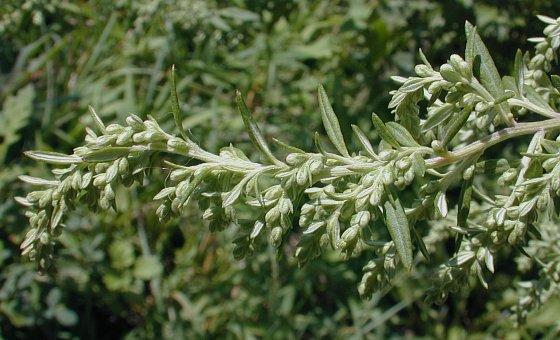
Range & Habitat: Surprisingly, Mugwort is a rather uncommon plant in Illinois, occurring in only a few counties in the northern half of the state (see Distribution Map). It was introduced into the United States from Eurasia as an herbal plant. Habitats include areas along railroads, edges of woods, prairie restorations, herbal gardens, and miscellaneous waste places. This plant usually occurs in disturbed areas, but it has displayed a capacity to invade more natural sites, even when fire is used as a management tool. This plant may become more of a problem in the future.
Faunal Associations: The flowerheads attract few insects because they are wind-pollinated. While the shrubby Artemisia spp. (Sagebrushes) of the western states are valuable to various kinds of wildlife, birds and mammals appear to make little use of the herbaceous Artemisia spp. that occur in the Midwest and NE states. The slightly aromatic foliage of Mugwort is bitter-tasting and toxic, containing cinerole and thujone. This latter substance is a neurotoxin. While Mugwort has been used in herbal medicine in the past, it can cause a variety of neurological problems and adverse reactions.

Photographic Location: Along the edge of a prairie restoration at Meadowbrook Park in Urbana, Illinois.
Comments: Mugwort is one of the introduced Artemisia spp. and rather nondescript in appearance. While significantly lobed, its leaves are usually broader than other Artemisia spp. and more tolerant of shade. These leaves are bicolored: green and largely hairless on the upper surface, but finely pubescent and powdery white underneath, whereas other Artemisia spp. tend to be either hairy or glabrous on both sides and less bicolored. Some Artemisia spp. have hairy or pubescent stems, while the stems of Mugwort are largely hairless (except for the upper flowering stems). Mugwort is unusual in having recurved lobes on its central disk florets – other Artemisia spp. usually have erect or spreading lobes on their disk florets. Because these florets are quite small in size, this can be difficult to observe without magnification from a hand or eye lens.
The inflorescence is a large panicle of leafy spikes with flowerheads. Each flowerhead is 1/8" (3 mm.) across or a little larger, consisting of numerous rayless florets. The florets in the center of the flowerhead are fertile and perfect, while the florets along the outer margin of the flowerhead are fertile and pistillate. The central florets are tubular with 5 recurved lobes, while the marginal florets have only 1 or 2 lobes. All of these florets have a divided style. At the base of the flowerhead are several floral bracts that are finely pubescent. Except for their abundance, these flowerheads are inconspicuous. At the bud stage they are whitish green, becoming dull yellowish green or purplish green with maturity. The blooming period occurs from late summer to early fall, and lasts about 1 month. Pollination is by wind. Each floret is replaced by an oblong achene that is without a tuft of hairs. These achenes are small and light enough to be blown about by the wind. The root system is quite rhizomatous, and often produces clonal colonies of plants.
Cultivation: Mugwort prefers full or partial sun and moist to slightly dry conditions. It adapts well to loam, clay-loam, or gravelly soil, and slightly acid to alkaline conditions. This plant can spread aggressively, forming dense colonies that exclude other plants.

Range & Habitat: Surprisingly, Mugwort is a rather uncommon plant in Illinois, occurring in only a few counties in the northern half of the state (see Distribution Map). It was introduced into the United States from Eurasia as an herbal plant. Habitats include areas along railroads, edges of woods, prairie restorations, herbal gardens, and miscellaneous waste places. This plant usually occurs in disturbed areas, but it has displayed a capacity to invade more natural sites, even when fire is used as a management tool. This plant may become more of a problem in the future.
Faunal Associations: The flowerheads attract few insects because they are wind-pollinated. While the shrubby Artemisia spp. (Sagebrushes) of the western states are valuable to various kinds of wildlife, birds and mammals appear to make little use of the herbaceous Artemisia spp. that occur in the Midwest and NE states. The slightly aromatic foliage of Mugwort is bitter-tasting and toxic, containing cinerole and thujone. This latter substance is a neurotoxin. While Mugwort has been used in herbal medicine in the past, it can cause a variety of neurological problems and adverse reactions.

Photographic Location: Along the edge of a prairie restoration at Meadowbrook Park in Urbana, Illinois.
Comments: Mugwort is one of the introduced Artemisia spp. and rather nondescript in appearance. While significantly lobed, its leaves are usually broader than other Artemisia spp. and more tolerant of shade. These leaves are bicolored: green and largely hairless on the upper surface, but finely pubescent and powdery white underneath, whereas other Artemisia spp. tend to be either hairy or glabrous on both sides and less bicolored. Some Artemisia spp. have hairy or pubescent stems, while the stems of Mugwort are largely hairless (except for the upper flowering stems). Mugwort is unusual in having recurved lobes on its central disk florets – other Artemisia spp. usually have erect or spreading lobes on their disk florets. Because these florets are quite small in size, this can be difficult to observe without magnification from a hand or eye lens.
0
0
成长记
choya8684
2018年07月24日

最近都放給它曬,約2週浸盆一次,顏色變紫了


1
0
choya8684:@丁嘉嘉 不不不,我最近也死了好幾顆,都不想更新了,哈哈哈!
丁嘉嘉:@choya8684 不過妳顧得很好啊!我後來乖乖搭起黑網,傷亡才降下來,不過也知道哪些比較耐曬了 😃
choya8684:@丁嘉嘉 我家直射時間頂多4小時,所以只擔心日照不夠而已
choya8684:@丁嘉嘉 好像說日照要循序漸近,一下子大太陽很容易曬傷的樣子
丁嘉嘉:最近做實驗把黑網拿掉,好幾顆都被我曬乾了😫
文章
Miss Chen
2018年07月23日

Brussels sprouts (Brassica oleracea variation gemmifera) are hardy biennial plants that typically are grown as annuals and do well in U.S. Department of Agriculture plant hardiness zones 2 through 10. Usually reaching 2 to 3 feet tall, the cool-weather plants thrive in air temperatures ranging from 45 to 75 degrees Fahrenheit. They can withstand frost, which reportedly makes the flavor of their vegetable portions -- sprouts -- even sweeter. The sprouts, which resemble tiny cabbages, usually take 80 to 100 days to mature. Harvest them when they are about 1 inch in diameter.
Growing the Plants from Seeds

Brussels sprout seeds should be started indoors about six to eight weeks before the area's average last frost date. Sow the seeds 1/2 inch deep and 2 inches apart in potting mix or nutrient-rich soil. The seedlings are ready to be transplanted once they have four or five leaves -- usually within four to six weeks.
Selecting and Preparing a Planting Area

Choose an outdoor planting area that gets at least six hours of sunlight daily; more than six hours per day is better. The site's soil should be well-drained and moist, with a pH level of 5.5 to 6.8 to maximize growth and prevent club root disease, a fungal infection that causes the leaves to wilt and turn yellow. Mix a time-released vegetable fertilizer into the soil before either transplanting seedlings or sowing seeds directly into the garden. Use a balanced fertilizer, such as a 13-13-13 blend, at a general rate of 1 tablespoon for every 1 square foot of planting area.
Planting Procedure

Planting brussels sprout seedlings 18 to 24 inches apart allows them space to mature. Plant them slightly deeper in the garden's soil than they were in their containers' soil, with their lowest leaves right above soil level. After planting, tamp the soil around each plant, and water the soil thoroughly. A 2- to 3-inch-thick layer of hardwood mulch on the soil surface, but not touching the plants, helps keep the soil moist and cool.
Caring for the Plants

Keeping the soil evenly moist but not waterlogged during the growing season is important. The plants require 1 to 1 1/2 inches of water weekly from rainfall and/or supplemental watering. Fertilize the plants by side-dressing them once when they are 1 foot tall. In order to do so, create a narrow, 1- to 2-inch deep furrow along the row of plants just beyond their widest branches. After spreading 1 tablespoon of ammonium nitrate in every 20 feet of the furrow, cover the furrow with soil.
Pruning the Plants and Handling Pests

Additional care for brussels sprouts includes pruning each plant's lowest six to eight leaves when the plant's stalk starts developing sprouts and removing each plant's growing tip about three weeks before you plan to harvest the sprouts. Watch for pests such as cabbage aphids and cabbage worms. Cabbage aphids are small, greenish-gray insects with a white covering, and wetting plants with a strong spray of water typically removes them. Cabbage worms -- green worms with a yellow stripe -- can be handpicked off plants.
Growing the Plants from Seeds

Brussels sprout seeds should be started indoors about six to eight weeks before the area's average last frost date. Sow the seeds 1/2 inch deep and 2 inches apart in potting mix or nutrient-rich soil. The seedlings are ready to be transplanted once they have four or five leaves -- usually within four to six weeks.
Selecting and Preparing a Planting Area

Choose an outdoor planting area that gets at least six hours of sunlight daily; more than six hours per day is better. The site's soil should be well-drained and moist, with a pH level of 5.5 to 6.8 to maximize growth and prevent club root disease, a fungal infection that causes the leaves to wilt and turn yellow. Mix a time-released vegetable fertilizer into the soil before either transplanting seedlings or sowing seeds directly into the garden. Use a balanced fertilizer, such as a 13-13-13 blend, at a general rate of 1 tablespoon for every 1 square foot of planting area.
Planting Procedure

Planting brussels sprout seedlings 18 to 24 inches apart allows them space to mature. Plant them slightly deeper in the garden's soil than they were in their containers' soil, with their lowest leaves right above soil level. After planting, tamp the soil around each plant, and water the soil thoroughly. A 2- to 3-inch-thick layer of hardwood mulch on the soil surface, but not touching the plants, helps keep the soil moist and cool.
Caring for the Plants

Keeping the soil evenly moist but not waterlogged during the growing season is important. The plants require 1 to 1 1/2 inches of water weekly from rainfall and/or supplemental watering. Fertilize the plants by side-dressing them once when they are 1 foot tall. In order to do so, create a narrow, 1- to 2-inch deep furrow along the row of plants just beyond their widest branches. After spreading 1 tablespoon of ammonium nitrate in every 20 feet of the furrow, cover the furrow with soil.
Pruning the Plants and Handling Pests

Additional care for brussels sprouts includes pruning each plant's lowest six to eight leaves when the plant's stalk starts developing sprouts and removing each plant's growing tip about three weeks before you plan to harvest the sprouts. Watch for pests such as cabbage aphids and cabbage worms. Cabbage aphids are small, greenish-gray insects with a white covering, and wetting plants with a strong spray of water typically removes them. Cabbage worms -- green worms with a yellow stripe -- can be handpicked off plants.
2
0



